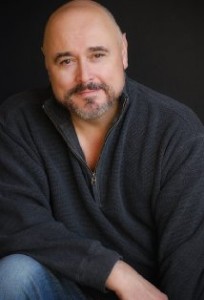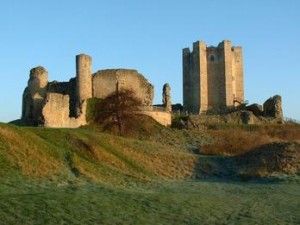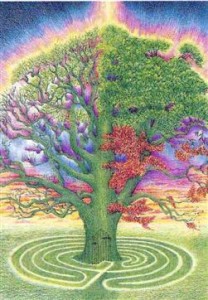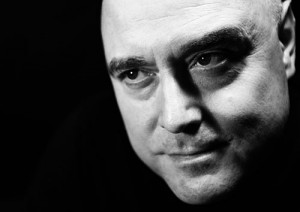This fall, Stevie Nicks released “In Your Dreams,” a personal documentary examining her life and career. Announcing the release, Ultimate Classic Rock remarked that the documentary’s release is “the most exciting news for the year for Wiccan candle…enthusiasts.” After all these years, the media still clings to the myth that Stevie Nicks is Pagan. In a 1998 online Yahoo interview, she was quoted as saying, “I’m not a witch. Get a life!”
Are there Pagan celebrities? Madonna, Demi Moore and others reportedly have studied the Kabbalah. Julia Roberts has openly converted to Hinduism. Although not mainstream, those spiritual paths are not necessarily Pagan. Neither Amy Ray, who loosely uses the word Pagan as a descriptive, nor Dar Williams, whose interfaith song “The Christians and the Pagans” has captured many an imagination, has openly professed to being Pagan.
When it comes down to it, there are very few entertainment celebrities who openly practice a Pagan spiritual path. There’s Sully Erma, Godsmack’s lead singer, and Teo Bishop, who revealed himself to be recording artist Matt Morris. Truthfully, we could probably count them on one hand. Fortunately, just this month, I had the opportunity to speak to one of these rare individuals – actor and writer, Mark Ryan.
 You might know Mark better as Nasir the Saracen from the popular British Television series Robin of Sherwood. However, that’s just one very small part of this his life’s journey. Mark, a true Renaissance man, has been combining his theatrical and writing talents in a successful career spanning more than 30 years. He has appeared in dozens of film, theater, and television productions both in the US and UK. He’s an accomplished swordsman and action director. As a writer, he has contributed to DC Comics and has produced two Tarot decks; the Greenwood Tarot and, the newly-released, Wildwood deck. Currently, he is co-hosting Combat Radio on internet-based LA Talk Radio.
You might know Mark better as Nasir the Saracen from the popular British Television series Robin of Sherwood. However, that’s just one very small part of this his life’s journey. Mark, a true Renaissance man, has been combining his theatrical and writing talents in a successful career spanning more than 30 years. He has appeared in dozens of film, theater, and television productions both in the US and UK. He’s an accomplished swordsman and action director. As a writer, he has contributed to DC Comics and has produced two Tarot decks; the Greenwood Tarot and, the newly-released, Wildwood deck. Currently, he is co-hosting Combat Radio on internet-based LA Talk Radio.
The hour long talk developed into more of a in-depth conversation than a traditional interview. Mark was very open about his childhood, his spiritual journey, his career, his beliefs, and the nature of Paganism in celebrity culture. An edited version of that interview, with video sound bites, will be published here in two parts.
Part I: A Conversation with Mark Ryan, October 4, 2012
Heather: You are openly Pagan. What type of Pagan spirituality do you follow?
Mark: I describe myself as an eclectic, philosophical Pagan because I don’t really know how else to describe it. I’m not a follower of any organized religion. I don’t accept the structure of the main three organized religions. So, [I asked] what structure is there? And that led me to this philosophical approach – to take the pieces that make sense to me philosophically, psychologically and scientifically and apply that in my life.
I have been in many [Pagan] circles. In San Francisco, there was a Golden Dawn-type group. They’ve all got their rules – the way that they do it. That just didn’t feel natural [to me.] It still doesn’t feel natural. A human being [can say], “This is what I’ve been told; therefore, this is the way you must do it.” I’ve always looked at these people and said, “Well, what about this?” I don’t care whether you walk your path by looking at crystals or reading tarot cards or reading tea leaves. To me, it’s all the same stuff. It’s your journey and it’s your path. So go do it. I respect everyone’s belief systems. As long as they don’t want to burn me at the stake because of mine, then I’m happy.
H: Which one came first, your Pagan journey or the entertainment career?
 M: I was born in a place called Doncaster, South Yorkshire, which was part of the Brigantian Celtic culture long before the Romans arrived. South of me was Sherwood Forest, which I played in as a child. We played Robin Hood surrounded by Conisbrough Castle – the castle used in Ivanhoe. And, York was up the road, which was a major Roman capital. There’s a whole history there of spiritual beliefs.
M: I was born in a place called Doncaster, South Yorkshire, which was part of the Brigantian Celtic culture long before the Romans arrived. South of me was Sherwood Forest, which I played in as a child. We played Robin Hood surrounded by Conisbrough Castle – the castle used in Ivanhoe. And, York was up the road, which was a major Roman capital. There’s a whole history there of spiritual beliefs.
As a child, I somehow absorbed the Arthurian, Robin Hood, nature-based stuff into my psyche. It just sunk in. The imagery and iconic ideas of the Arthurian Legend and Robin Hood stayed with me as a guide and a way of looking at the world. The Lady of the Lake, the Sword and the Stone and the King – this spoke to me on a deep emotional level. The Church did not. I had questions about the Bible. I would embarrass myself in religious instruction classes by asking awkward questions for which the teachers had no answer.
H: So, when you started performing, were you formally following this alternative spiritual path?
M: No. It was a long, strange and twisted path. I grew up with a lot of tragedy in my family. But that pushes you to think, “Okay, you are going to die.” How are you going to deal with death? How are you going to deal with life? That really colored my attitude to both life and achieving things in life.
After I got to London, [along] came Robin of Sherwood. [It] was such a natural fit.
H: Tell us the story behind the creation of The Greenwood Tarot.
 M: The artist, Chesca Potter, [and I] were sitting around one night talking about why Robin of Sherwood had had such an impact on the magical world. We were talking about that nature of why those characters speak to people to this day. To this day! Out of that discussion came the concept of the major 22 arcana and 22 types of personality. It started almost like an experiment. Chesca wanted to know if I wanted to do a Robin of Sherwood tarot. I said, “No, we’re too close to it.” I thought it was too narrow a vision, to be honest.
M: The artist, Chesca Potter, [and I] were sitting around one night talking about why Robin of Sherwood had had such an impact on the magical world. We were talking about that nature of why those characters speak to people to this day. To this day! Out of that discussion came the concept of the major 22 arcana and 22 types of personality. It started almost like an experiment. Chesca wanted to know if I wanted to do a Robin of Sherwood tarot. I said, “No, we’re too close to it.” I thought it was too narrow a vision, to be honest.
I bought my first Tarot deck in 1979. It was the Morgan Greer or Voyager Tarot. But it didn’t speak to me, because I don’t understand Kabbalah. It just does not resonate with me. As I was learning about the Wheel of the Year, [Chesca and I] started to lay out these archetypes around the Wheel. That made instantaneous visual, emotional, and practical sense.
I called John Matthews. I said, “John, we just laid out the tarot arcana in this wheel on the floor. Does this make any sense to you? Does it have validity?” He said, “I wish I had done that! It actually makes total sense. I don’t think anybody’s done that before. There have been other [decks] that have been based on the Wheel of the Year. But the way you’ve done it makes instantaneous, visual sense to me.”
H: Greenwood was very popular but it is now out of print, correct?
M: Yes. It is out of print. I have one copy, the original proof. I get asked if it’s me selling the Greenwood Tarot online for $2-3,000 a deck. No. I don’t get any money from those sales. I only have the original proof.
To Be Continued: Tomorrow, I’ll pick up the conversation with Mark as he takes us from the mysteries of the Greenwood into the depths of the Wildwood and beyond!

The Wild Hunt is not responsible for links to external content.
To join a conversation on this post:
Visit our The Wild Hunt subreddit! Point your favorite browser to https://www.reddit.com/r/The_Wild_Hunt_News/, then click “JOIN”. Make sure to click the bell, too, to be notified of new articles posted to our subreddit.

when Cybill Shepherd thanked “The Goddess in all Her forms” when winning an Emmy or a Golden Globe. according to Wikipedia “Shepherd has described her religious beliefs as ‘a goddess-worshipping Christian Pagan Buddhist’.”
I remember when Ms. Shepherd received her award (in the mid-90s?). Her acceptance was the talk of the community, and I remember that the New Moon, New York newsletter had an article reporting on it: She said something to the effect that “those who needed to understand what she was going to say, would.” All in all, it struck many at the time as very “Pagan.”
I’ve come across interviews with writer Erica Jong (notable for a beautifully illustrated book on Witches in the early ’80s), in which she describes herself as a “Born Again Pagan.”
Possibly a bit niche, but you will find quite a large amount of ‘Pagans’ within the Metal genre of music.
From Varg Vikernes of Burzum (also a published author on Scandinavian sorcery and religion) to bands such as Agalloch and Falkenbach, you can find people expressing their beliefs through music.
I think that it is more ‘okay’ for people interested in metal music to be openly ‘Pagan’ as they are seen as counter-culture and ‘rebellious’ already.
Amy Brennemen has said that she marks special times and seasons of the year with her group of female friends she calls her “girl tribe”, and said she was “witchy”. I was so proud of her! She made these remarks on “The Talk”. She may not be specifically Pagan, but it sure sounds like she is one of us!
i like to think of famous people as employed rather than out of our stratosphere it demystifies them and makes us work harder. idol worship of people on stage and screen is probably as popular now as it ever was but we might know about their philosophical meanderings because unlike working stiffs they often agree to interviews. and let’s remember when we talk about others we’re really commenting on ourselves.